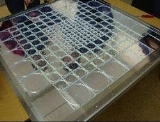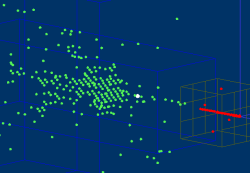
CALICE
Encyclopedia
The CALICE collaboration https://twiki.cern.ch/twiki/bin/view/CALICE/ is R&D group of more than 280 physicists and engineers from around the world, working together to develop new, high performance detectors for high energy positron
-electron
( ) experiments at future International Linear Collider
) experiments at future International Linear Collider
(ILC). It is a part of European EUDET project.
The physics requirements of a future TeV-scale machine such as the ILC demand extremely high performance calorimetry. This is best achieved using a finely segmented system that allows to reconstruct events using the so-called Particle Flow Approach (PFA).
machine such as the ILC demand extremely high performance calorimetry. This is best achieved using a finely segmented system that allows to reconstruct events using the so-called Particle Flow Approach (PFA).
The calorimeter systems for high energy physics experiments usually consist of three main subsystems: electromagnetic calorimeter (ECAL) to detect electromagnetic showers produced by electrons (or positrons) and photons, hadronic calorimeter (HCAL) to measure hadron-induced showers, and muon tracker (or so-called tail catcher) to identify highly penetrating particles such as muons.
CALICE has developed prototypes of the three main calorimetric subsystems of a future detector:ECAL followed by HCAL and tail catcher/muon tracker (TCMT), and is evaluating the performance of alternative technological solutions within this combined system.
The collaboration studies the performance of such calorimeters within a long, detailed program for an ECAL and several options of high granular analogue and digital calorimeters with sensitive layers of gas or plastic scintillator
. The Tile- subgroup http://www-flc.desy.de/hcal/ has built a 1 steel/scintillator sandwich sampling hadronic calorimeter (HCAL) called physics prototype for study series in various test particle beams.
steel/scintillator sandwich sampling hadronic calorimeter (HCAL) called physics prototype for study series in various test particle beams.
 High granularity is achieved by 38 scintillator tile layers . Each layer is a 2-
High granularity is achieved by 38 scintillator tile layers . Each layer is a 2-  thick steel plate 90x90
thick steel plate 90x90  followed by 0.5-
followed by 0.5-  scintillator plate that consists of more than 200 scintillator tiles.
scintillator plate that consists of more than 200 scintillator tiles.
The mosaic of HCAL layers exhibits a hundred 3x3 tiles in the center , surrounded by a large area covered with 6x6
tiles in the center , surrounded by a large area covered with 6x6  tiles and finally enclosed by a strip of 12x12
tiles and finally enclosed by a strip of 12x12  tiles. All these near 8000 tiles in total are read out individually by wavelength-shifter fibers which illuminate small Silicon Photomultiplier
tiles. All these near 8000 tiles in total are read out individually by wavelength-shifter fibers which illuminate small Silicon Photomultiplier
(SiPM) mounted on each tile and insensitive to large magnetic field.
s ( ) is headed by electromagnetic calorimeter (Silicon-Tungsten ECAL) near 1-
) is headed by electromagnetic calorimeter (Silicon-Tungsten ECAL) near 1-  in thickness and followed by a 5-
in thickness and followed by a 5- thick tail catcher to measure the hadronic shower leakage.
thick tail catcher to measure the hadronic shower leakage.
For today, the sampling calorimeter has been calibrated to get its signal vs. the incident particle energy dependence using test beams of different incident particle sorts with known energies in the range from 4 GeV to 120 GeV. The corrections for the calorimeter non-linearity and the external temperature influence have been taken into account. For test beams with energy 50 GeV the precision of incoming particle energy reconstruction was estimated to be near 4%.
 Now, given some number of unknown incoming particles , it is possible to reconstruct their energies using the picture of particle showers born in the calorimeter. That picture have to be analyzed by a PFA program . In addition novel Deep Analysis (DA) algorithm has been developed to separate different sorts of secondary particles inside showers in order to improve the energy reconstruction.
Now, given some number of unknown incoming particles , it is possible to reconstruct their energies using the picture of particle showers born in the calorimeter. That picture have to be analyzed by a PFA program . In addition novel Deep Analysis (DA) algorithm has been developed to separate different sorts of secondary particles inside showers in order to improve the energy reconstruction.
The unprecedented granularity of CALICE calorimeter prototype provides an opportunity to test the Particle Flow concept. These days the work is in progress to check the output quality of the PFA programs . Due to large amount of test beam data, it becomes possible to use real events instead of simulated ones as input information for that programs. Since in the test beams all the particles are almost at the same coordinate position, there are created artificial events consisting of several incoming particles separated by some distance in order to check if the PFA program could to reconstruct the incoming particles right.
Positron
The positron or antielectron is the antiparticle or the antimatter counterpart of the electron. The positron has an electric charge of +1e, a spin of ½, and has the same mass as an electron...
-electron
Electron
The electron is a subatomic particle with a negative elementary electric charge. It has no known components or substructure; in other words, it is generally thought to be an elementary particle. An electron has a mass that is approximately 1/1836 that of the proton...
(
 ) experiments at future International Linear Collider
) experiments at future International Linear ColliderInternational Linear Collider
The International Linear Collider is a proposed linear particle accelerator. It is planned to have a collision energy of 500 GeV initially, and, if approved after the project has published its Technical Design Report, planned for 2012, could be completed in the late 2010s. A later upgrade to 1000...
(ILC). It is a part of European EUDET project.
The physics requirements of a future TeV-scale
 machine such as the ILC demand extremely high performance calorimetry. This is best achieved using a finely segmented system that allows to reconstruct events using the so-called Particle Flow Approach (PFA).
machine such as the ILC demand extremely high performance calorimetry. This is best achieved using a finely segmented system that allows to reconstruct events using the so-called Particle Flow Approach (PFA).The calorimeter systems for high energy physics experiments usually consist of three main subsystems: electromagnetic calorimeter (ECAL) to detect electromagnetic showers produced by electrons (or positrons) and photons, hadronic calorimeter (HCAL) to measure hadron-induced showers, and muon tracker (or so-called tail catcher) to identify highly penetrating particles such as muons.
CALICE has developed prototypes of the three main calorimetric subsystems of a future detector:ECAL followed by HCAL and tail catcher/muon tracker (TCMT), and is evaluating the performance of alternative technological solutions within this combined system.
The collaboration studies the performance of such calorimeters within a long, detailed program for an ECAL and several options of high granular analogue and digital calorimeters with sensitive layers of gas or plastic scintillator
Scintillator
A scintillator is a special material, which exhibits scintillation—the property of luminescence when excited by ionizing radiation. Luminescent materials, when struck by an incoming particle, absorb its energy and scintillate, i.e., reemit the absorbed energy in the form of light...
. The Tile- subgroup http://www-flc.desy.de/hcal/ has built a 1
 steel/scintillator sandwich sampling hadronic calorimeter (HCAL) called physics prototype for study series in various test particle beams.
steel/scintillator sandwich sampling hadronic calorimeter (HCAL) called physics prototype for study series in various test particle beams.
 thick steel plate 90x90
thick steel plate 90x90  followed by 0.5-
followed by 0.5-  scintillator plate that consists of more than 200 scintillator tiles.
scintillator plate that consists of more than 200 scintillator tiles.The mosaic of HCAL layers exhibits a hundred 3x3
 tiles in the center , surrounded by a large area covered with 6x6
tiles in the center , surrounded by a large area covered with 6x6  tiles and finally enclosed by a strip of 12x12
tiles and finally enclosed by a strip of 12x12  tiles. All these near 8000 tiles in total are read out individually by wavelength-shifter fibers which illuminate small Silicon Photomultiplier
tiles. All these near 8000 tiles in total are read out individually by wavelength-shifter fibers which illuminate small Silicon PhotomultiplierPhotomultiplier
Photomultiplier tubes , members of the class of vacuum tubes, and more specifically phototubes, are extremely sensitive detectors of light in the ultraviolet, visible, and near-infrared ranges of the electromagnetic spectrum...
(SiPM) mounted on each tile and insensitive to large magnetic field.
Present status
The very important experimental part of this project is now in progress: a combined test beam program involving exposure of combined prototype calorimeter system to real particle beams from different accelerators and subsequent data analysis. In test beam studies the Tile-HCAL with effective thickness 4.5 nuclear interaction lengthNuclear interaction length
Nuclear interaction length is the mean path length required to reduce the numbers of relativistic charged particles by the factor 1/e, or 0.368, as they pass through matter....
s (
 ) is headed by electromagnetic calorimeter (Silicon-Tungsten ECAL) near 1-
) is headed by electromagnetic calorimeter (Silicon-Tungsten ECAL) near 1-  in thickness and followed by a 5-
in thickness and followed by a 5- thick tail catcher to measure the hadronic shower leakage.
thick tail catcher to measure the hadronic shower leakage.For today, the sampling calorimeter has been calibrated to get its signal vs. the incident particle energy dependence using test beams of different incident particle sorts with known energies in the range from 4 GeV to 120 GeV. The corrections for the calorimeter non-linearity and the external temperature influence have been taken into account. For test beams with energy 50 GeV the precision of incoming particle energy reconstruction was estimated to be near 4%.

The unprecedented granularity of CALICE calorimeter prototype provides an opportunity to test the Particle Flow concept. These days the work is in progress to check the output quality of the PFA programs . Due to large amount of test beam data, it becomes possible to use real events instead of simulated ones as input information for that programs. Since in the test beams all the particles are almost at the same coordinate position, there are created artificial events consisting of several incoming particles separated by some distance in order to check if the PFA program could to reconstruct the incoming particles right.

